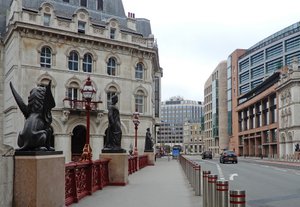Advertisement
Published: January 4th 2020

 Holborn Viaduct
Holborn Viaduct
Well worth seeing, albeit better to planMy walk to the
Royal Albert Hall was both fun and almost disastrous. Even though I had worked out the easiest route
(see map) for the one hour walk, my morning confidence took me along other streets I thought were parallel to
Tottenham Court Road. Hardly anyone was on the street, and I enjoyed my allotted time for casual photos along the way.
(see map). While I was taking photos of the Holborn Viaduct, I thought to check if the street running under the bridge was Oxford Street. It was not, and I was walking far away from my destination. Retracing my steps at a fast pace, but over a considerable distance, I finally found Oxford Street (no proper signs, course), although it looked quite down-market compared to my admittedly dated memory.
Hastening down the street, the store quality improved. Lots of buses roared by. The way was much longer than I had thought it would be, and I kept checking my watch to see if I would make it to the concert on time. When I had finally convinced myself that a taxi would be needed, they all disappeared! Walking quickly and glancing backwards to spy a taxi going my way, I saw two going

 Royal Albert Hall
Royal Albert Hall
Magnificent locale for resounding musicagainst me. I hailed one, and of course he did a U-turn, let me in, and drove … and drove … and drove. The distance shocked me. Eleven pounds later, I dashed from the taxi and breezed through the bag search and ticket scan. Luckily close to my seating section and running up the stairs, I heard the three-minute warning for the concert. As I stumbled to my seat over people’s feet, the orchestra entered the stage.
What a venue! Completely circular, the Hall’s seats were all around, except where the pipe organ gleamed in eerie purple-blue light. My seat was in the “Rausing Circle”, known as the nosebleeds in hockey parlance. The acoustics were perfect. Even the sound of a solo horn filled the space. The bottom level, named “The Arena” was full of people standing, and in the “Gallery” above me, more people were standing. The Tiers, Loggia and Stalls were below me. The rows were steeply raked, so my view was perfect, and probably it was for everyone else, except those behind the stage near the organ. Viewing the orchestra from such a high angle, the bare arms of the women violinists gave the appearance of
a school of undersea fish, waving and fluttering in harmony.
When my astonishment faded enough to turn attention to the music, the piece was in a spiky style that I did like. (
">Fireworks by Agata Zubel) The orchestra was enormous, including seven percussionists making the most extraordinary sounds in ways I couldn’t quite see. There were twelve double bases, and the horns were at the back of these. The next piece was the one that attracted me when I bought the tickets months ago – a young pianist playing Chopin (Concerto #2 in F minor). His fingering was light and effortless. That reminded me of reading Alan Rusbridger’s book,
, which explained how hard it is to play quickly with great musical interpretation. The applause was as enthusiastic as the pianist’s playing, leading to an encore - a classical dance tune I recognized but couldn’t name.
Oddly, I thought that was the end of the concert, but so many people were sitting around, I decided to wait and see what was going to happen. The other half of the concert happened:
























Isabel Gibson
non-member comment
Farther than it looks
Yikes. Good thing you nabbed a cab when you did. Your description of the concert almost transfers your enthusiasm to this less-than-knowledgeable audience member. And your photos nicely evoke a unique building I knew nothing about beyond its name.